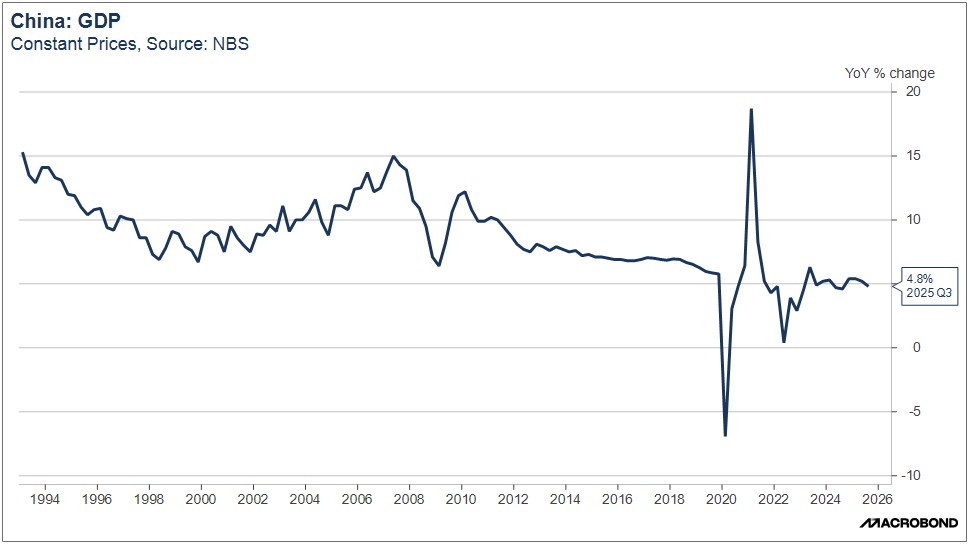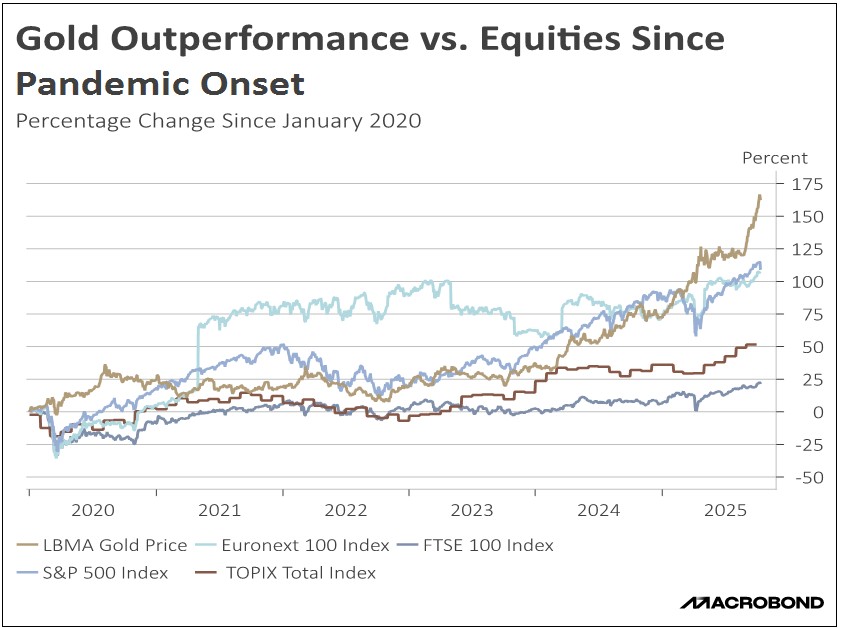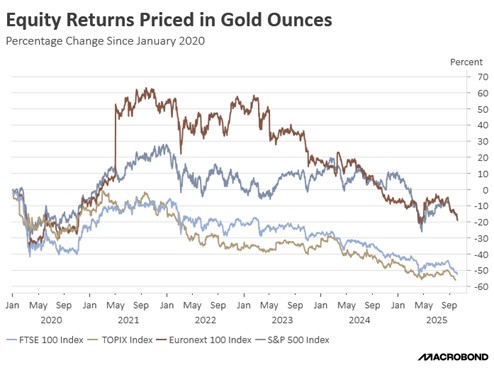by Patrick Fearon-Hernandez, CFA, and Thomas Wash
[Posted: 9:30 AM ET] | PDF
Our Comment section opens with an unraveling of the reasons behind the market’s recent breather. This is followed by a crucial look at US monetary policy, specifically analyzing how scant jobs data could constrain the Federal Reserve’s next interest rate decision. We also discuss a major quantum technology breakthrough, the latest in the US-China trade escalation, and North Korea’s weapons advancements. Finally, we provide a concise summary of the day’s essential US and global economic indicators.
Rally Cools: While many companies reported strong earnings, high-profile disappointments from several key players raised red flags. Tesla, for instance, saw record vehicle sales undermined by shrinking profit margins, fueling doubts about its adaptability in a less EV-friendly environment. Similarly, Netflix fell short of earnings targets, largely attributed to a regulatory dispute in Brazil, while Texas Instruments dampened sentiment with a pessimistic forward outlook.
- The market’s narrow focus reflects heightened anxiety over a lack of economic data due to the government shutdown, which has severely hampered the ability to assess the economy’s health. This is particularly concerning amid rising fears about consumer strain and a potential credit crunch. Auto loan troubles at firms like First Brand and Tricolor, coupled with mounting fears that small lenders are carrying a significant amount of bad debt on their books, has largely driven this anxiety.
- Investor confidence in the economy has been heavily reliant on the remarkable resilience of the consumer. Against all odds, consumer spending has consistently defied recessionary warnings, weathering several significant scares over the past three years — from the collapse of Silicon Valley Bank in 2023 to the triggering of the Sahm Rule in 2024 and the ongoing pressures of this year’s trade war.
- Thursday’s market action reflects a market in search of its next catalyst due to the lack of government data. We attribute the recent dip in sentiment to routine profit-taking following several strong quarters and view it as a temporary consolidation. We expect a more definitive market direction to emerge after the upcoming US-China trade talks and the Fed’s policy meeting. We believe that these two catalysts will ultimately provide a supportive backdrop for equities.
Central Bank Data: The Federal Reserve is now operating with a reduced level of vital information following a dispute that led private payroll processor ADP to halt its data sharing. ADP, which tracks payroll for approximately 20% of the US labor force, provided a crucial, high-frequency gauge of the job market. This data loss is particularly challenging now, as the government’s official labor reports are unavailable due to the shutdown, severely complicating the Fed’s ability to accurately assess the job market.
- The dispute stems from comments made by Fed Governor Chris Waller, who cited preliminary ADP estimates — before their public release — to justify his cautious outlook on the economy. This unusual disclosure inadvertently raised concerns (later debunked) that ADP was sharing proprietary client-level information, prompting the company to terminate the data feed.
- This data shortfall arrives at a critical juncture, amplifying a deep policy split among Fed officials regarding their dual mandate. One faction is advocating for accommodative policies to counteract persistent signs of labor market weakness. The opposing group, however, argues that rising price pressures — exacerbated by the effect of tariffs flowing through the economy — demand a cautious stance to prevent fueling inflation, making rate cuts ill-advised at this time.
- The absence of reliable ADP data, which has historically tracked the long-run employment trend despite short-term differences from monthly government figures, makes resolving the Fed’s internal policy debate considerably more difficult. However, clarity is expected tomorrow with the release of the Consumer Price Index (CPI) report. A softer-than-expected inflation reading would likely pave the way for the Fed to pursue another rate cut at its October 28-29 meeting.
Quantum Leaps: Alphabet, Google’s parent company, has announced a quantum computing breakthrough: It has successfully executed a novel algorithm on its “Willow” chip that outperformed the world’s leading classical supercomputers by a staggering 13,000%. This milestone bolsters the conviction that practical quantum technology could be within reach in five years, with near-term applications expected to revolutionize drug discovery and materials science. The achievement also reinforces the US’s dominant technological lead over China.
New US Curbs: The White House is threatening to impose extensive new curbs on software exports to China, a powerful countermeasure to Beijing’s recent restrictions on rare earth elements. This policy debate intensifies trade friction ahead of the preparatory trade talks scheduled for Friday in Malaysia, which precede the anticipated meeting between President Trump and President Xi Jinping in South Korea. Despite trade tensions, we remain optimistic that the two sides will come to an agreement.
Russia Sanctions: Following a recent breakdown in talks with Moscow, the White House is significantly escalating sanctions against Russian oil companies. The US is directly targeting oil giants Rosneft and Lukoil, which together account for 5% of global output. This move has contributed to a broader increase in oil prices. The sanctions are intended to cripple Russia’s ability to finance its war efforts and pressure the Kremlin back to the negotiating table.
US Drug Clash: The United States is intensifying its efforts against organizations it designates as narco-terrorists, extending its operational reach from the Caribbean into the Pacific. This new, more hawkish posture was demonstrated by two recent US military strikes on suspected narcotics vessels. While the current justification is disrupting the drug trade, this escalation in military force could set a precedent for armed intervention for other purposes in the future.
North Korea Weapons: North Korea has announced the successful test of a new hypersonic weapon, signaling significant advances in its weapons technology. These missiles are designed to travel at such high speeds that they are virtually undetectable by current missile defense systems, making them extremely difficult to intercept. The announcement comes as world leaders prepare to gather in South Korea for the APEC conference, a timing that underscores North Korea’s intent to project strength and military prowess to its rivals.






